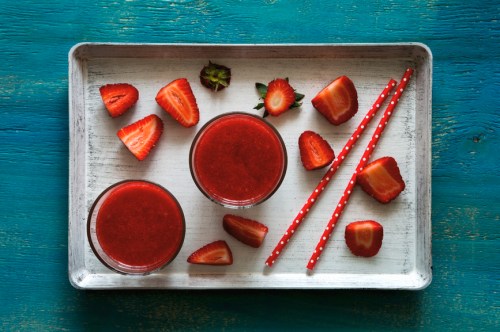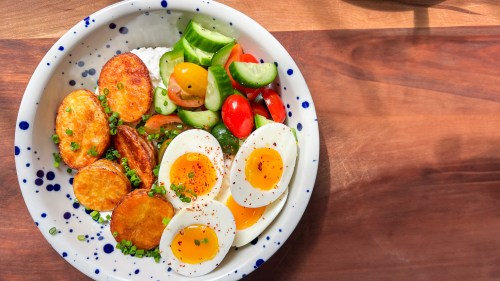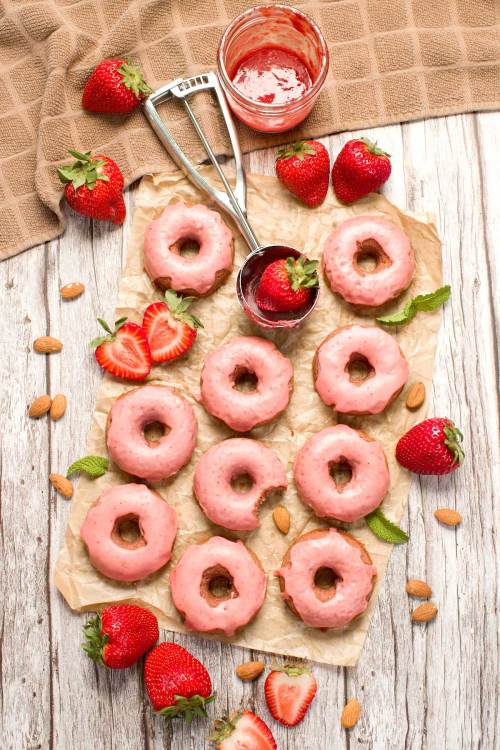This Is Why Smoothies Always Taste Better When You Buy Them at the Juice Bar
Learn this simple trick for how to freeze fruit like a professional juice bar that costs a fraction of the price.

In the early 2000s, going to the mall to pick up a 30-ounce Strawberry Surf Rider at Jamba Juice was *the* way to stave off the hot summer days.
Today, you can find endless smoothie recipes all over the internet for daily inspiration for making this refreshingly fruity beverage at home. But admit it: Those pricey smoothies from the local juice bar always hit different. They never fail to taste a little thicker, sweeter, and creamier than the ones you make yourself, no?
This is partially due to the fact that we (of course) need some sort of viable excuse for spending $11 on a beverage, but there is certainly something different about the texture of professionally-made smoothies. After all, making the perfect smoothie depends a lot on both how and what we’re using to make them. And no, we’re not referencing the fact that your local juice bar uses a super fancy high-performance blender or that they’re whirling in elusive locally-grown organic strawberries and spirulinasuperfoodcollagenCBDmagicfairydust. Rather, if you feel that homemade smoothies simply lack the velvety texture of their store-bought counterparts, the problem might be in the way that you’re freezing your fruit at home versus the more effective method that professionals in restaurants and juice bars use.
Indeed, the texture of your frozen fruit can be *the* determining factor between a super vibrant and creamy, cohesive smoothie that tastes like summer in a cup versus a bland, icy, and mediocre-tasting drink. Follow these simple tips for prepping and freezing your fresh fruit the right way, and you’ll never have to shell out a ridiculous amount for a high-quality smoothie again.
How to freeze fruit for making smoothies at home
1. Freeze them when they’re super ripe
Overshot how much fruit you’ll need for the week and now you’re left with a heaping pile of berries that are on the brink of starting to spoil? No sweat. Catch them at their peak ripeness (read: after they’ve softened and sweetened but not before they’re begun to mold) and freeze them ASAP. This will maximize the natural sweetness of your smoothies.
2. Wash them thoroughly
It’s important to wash your fresh produce thoroughly to remove any dirt, bacteria, or harmful pesticides from its delicate skin, especially for fruits like strawberries and peaches. According to the FDA, you don’t need to use any soap or produce sprays to get the job done. Instead, rinsing fruits (and veggies) under cool running water can help remove excess dirt to help prevent any foodborne illnesses. Although, if you find that your strawberries look extremely dirty, you can soak them in a solution of water and vinegar for just a few minutes before rinsing them again.
3. Dry, dry, and dry them again
To prevent any unwanted freezer burn and icicles from forming on your frozen fruit, make sure to dry it extremely well. Gently pat the fruit with a paper towel or clean washcloth, and remove all moisture as best as possible before attempting to freeze.
4. Prep the fruits (or vegetables) for freezing
Once your produce is clean and dry, cut each piece of fruit into smaller pieces to make blending them into a uniform and creamy smoothie a breeze (it’ll also be easier on your equipment). Having the fruit already cut up makes portioning it out for individual smoothies all that faster, too.
5. Freeze fresh pieces of fruit on a baking sheet first
So, the time has come to freeze them, but how exactly do juice bars nail it every time? Using a baking sheet, of course. This TikTok video by @nutreats demonstrates how to freeze fruit in a few easy steps for smoothie perfection.
They’re not just great for baking a batch of chocolate chip cookies: Baking sheets are the holy grail of restaurant kitchen tools and are an essential part of freezing fruit effectively at home. To do so, line a baking sheet with parchment paper or a reusable, freezer-safe silicone mat. Then, place the clean and dry fruit in a single layer and pop it in the freezer for a few hours.
By freezing the pieces of fruit in a uniform layer on a baking sheet, you’ll prevent them from becoming one giant hunk of bananas or berries that makes it nearly impossible to blend or portion out. After a few hours of “flash freezing” them, they’ll be solid enough to consolidate into a freezer-safe reusable bag without sticking to one another. The result? Perfectly ripe, sweet, and freezer burn-free pieces of fruit that are just as good as the ones your juice bar blends.
6. Don’t freeze these fruits and veggies
Although this trick works wonders for strawberries, bananas, and blueberries, some produce is better left unfrozen. Frozen watermelon, citrus slices, cucumbers, and apples tend to become mushy or oxidize quickly. Thus, sticking to freezer-resistant ingredients will help ensure that your smoothies will always meet your creamy and dreamy expectations.
Try making this brain-boosting smoothie with all of your freshly frozen fruit:
Oh hi! You look like someone who loves free workouts, discounts for cutting-edge wellness brands, and exclusive Well+Good content. Sign up for Well+, our online community of wellness insiders, and unlock your rewards instantly.
Sign Up for Our Daily Newsletter
Get all the latest in wellness, trends, food, fitness, beauty, and more delivered right to your inbox.
Got it, you've been added to our email list.










